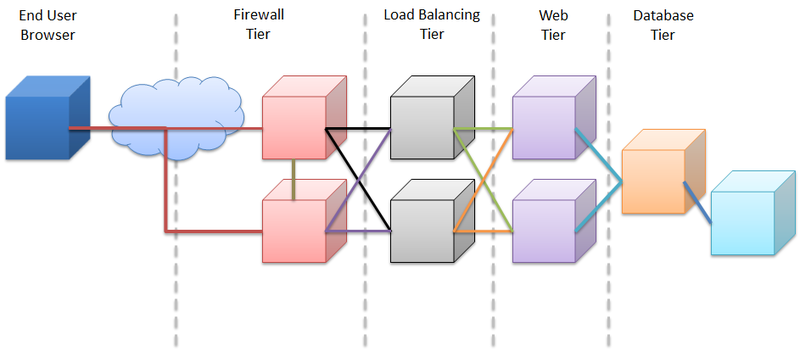Bxp - End to End encryption and High Availability
From All n One's bxp software Wixi
Contents
1 Overview
With the release of BER8 Service Enhancement Release 2, our solution now provides End to End encryption and High Availability. So what does that mean?
End to End encryption : At no point between the users browser and data stored in the databases is the data ever unencrypted and is only accessible by the system owners. This is not to be confused with the E2EE paradigm ( http://en.wikipedia.org/wiki/End-to-end_encryption ) though its not far off and something All n One are working towards.
High Availability : There is no single device point of failure, there is physical backup for every point in the infrastructure.
2 Hosting
Firstly all of our storage is the secure operating facility of Sungard in Parkwest in Dublin. For more information Bxp_software_in_Sungard
bxp uses an n-Tier design architecture ( http://en.wikipedia.org/wiki/Multitier_architecture )
3 Logical Architecture
3.1 End User Browser
The first part of the data journey starts with the end users browser. All communications with the bxp service are encrypted using an SSL certificate verified by Thawte.
For more information on HTTPS : HTTPS_and_Thawte_SSL
3.2 Firewall Tier
The Firewall tier is implemented using Cisco equipment and does not decrypt the packets transmitted from the browser.
The firewall tier is monitored 24x7 by the Technical Operations Centre of Sungard to prevent DDos and other mass orchestrated malicious attacks.
Using the numerous communication links and connections, a guarantee of 100% connectivity is always available at this level.
3.3 Load Balancing Tier
The load balancing tier decrypts and re-encrypts the packets to add extra security information vital to the bxp service, including the remote users IP address.
The load balancers detect slow down and the responsiveness of the web tier and swaps users seamlessly between servers to ensure the fastest response times possible to our end users.
The load balancing tier is designing in such a way as to allow numerous other load balancers to be added into the infrastructure seamlessly as demand requires.
3.4 Web Tier
The web tier is implemented using the High Availability Microsoft Internet Information Server (IIS) again in an architecture way that allows numerous servers to be added as demand requires.
It is finally at this tier that the encrypted SSL packets from the users browser are decrypted and used. Instructions at this stage usually require some form of database interaction. Communications from the web servers to the database tier are then encrypted using SSL over ODBC. ( http://dev.mysql.com/doc/refman/5.6/en/ssl-connections.html )
At no point is decrypted data stored on the IIS server.
3.5 Database Tier
Finally the data, such as a customer record, reaches the database tier. The data is stored in a primary server, with a secondary mirroring backup server in identical configuration logging the data.
The data from IIS is decrypted and stored in the database.
However the hard drives in the database server are also encrypted at the operating system level. The term for this is that "the data is encrypted at rest". ( http://technet.microsoft.com/en-us/library/cc732774.aspx )
All data backups at this point are encrypted into Zip files using AES 256 encryption. ( http://www.winzip.com/aes_info.htm )




